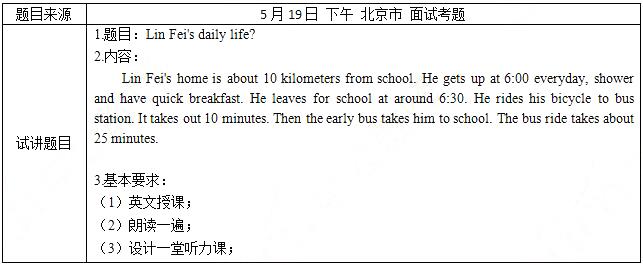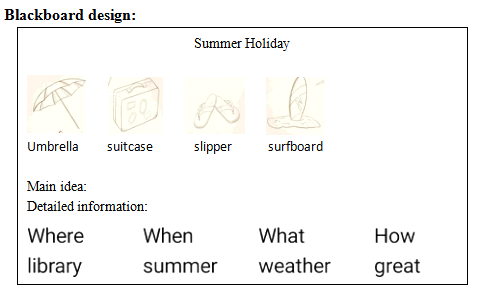When teaching students how to give appropriate responses to a congratulation or an apology, the teacher is probably teaching at _. A. lexical level B. sentence level C. grammatical level D. discourse level
题目
When teaching students how to give appropriate responses to a congratulation or an apology, the teacher is probably teaching at _.
A. lexical level
B. sentence level
C. grammatical level
D. discourse level
B. sentence level
C. grammatical level
D. discourse level
相似考题
更多“When teaching students how to give appropriate responses to a congratulation or an apology, the teacher is probably teaching at _. ”相关问题
-
第1题:
When the teacher gives feedback to students in teaching writing, he/she should NOT__________.A.make positive comments on the good features of the writing
B.give words simply like "good" or "very good" to the writing
C.point out areas for improvement
D.express his/her personal opinion on the issue the writer has discussed答案:B解析:考查教学反馈。教师给予学生反馈时,不能仅仅写个简单的评语“好”,这对于学生写作技能的提高没有任何帮助:而应该指出哪里写得好,哪里有待改进,并针对学生在作文中发表的观点给出自己的意见。故选B。 -
第2题:
During class, the teacher leads students to memorize the important points of the teaching content. On one hand, the teacher helps students to grasp the key points. On the other hand, what learning strategy is the teacher teaching?A.Cognitive strategy
B.Self-management strategy
C.Communication strategy
D.Resource strategy答案:A解析:本题考查英语学习策略
A选项,老师在教学中引导学生对教学要点进行记忆,一方面是为了让学生了解课程内容的重点,另一方面是为了传授学生学习策略,而在学习中记住要点是属于学习策略中的认知策略。综上,A选项正确。
B选项,自我管理策略,故排除。
C选项,交际策略 ,故排除。
D选项,资源策略 ,故排除。
故正确答案为A 项。 -
第3题:
Which of the following should a teacher avoid when his/her focus is on developing students' ability to use words appropriately?A.Teaching both the spoken and written form.
B.Teaching words in context and giving examples.
C.Presenting the form, meaning, and use of a word.
D.Asking students to memorize bilingual word lists.答案:D解析:本题考查语言知识教学。题干的意思:如果教师专注于培养学生恰当地使用单词的能力,那么他/她应该避免以下哪种方式A项“教单词的口语和书面形式”,B项“在语境中教单词并举例子”,C项“呈现单词的形式、意义及用法”,D项“要求学生记忆双语单词表”。在词汇教学中,教师不仅要讲授单词的形式,还要创设具体的语境,让学生在运用中加深对词汇意义的理解,掌握词汇的用法和功能,进而恰当得体地运用词汇表情达意。记忆双语单词表属于单纯的记忆活动,不能起到促进学生恰当使用词汇的作用。故本题选D。 -
第4题:
During class,the teacher leads students to memorize the important points of the teaching content.On one hand,the teacher helps students to grasp the key points.On the other hand,what learning strategy is the teacher teaching?A.Cognitive strategy.
B.Self-management strategy.
C.Communication strategy.
D.Resource strategy.答案:A解析:本题考查新课标相关的英语学习策略
A选项,认知策略,老师在教学中引导学生对教学要点进行记忆,一方面是为了让学生了解课程内容的重点,另一方面是为了传授学生学习策略,而在学习中记住要点是属于学习策略中的认知策略。综上,A选项正确。
B选项,自我管理策略,故排除。
C选项,交际策略 ,故排除。
D选项,资源策略 ,故排除。
故正确答案为A 项。 -
第5题:
When teaching students how to give appropriate responses to a congratulation or an apology,the teacher is probably teaching at _________.
A.lexical level
B.sentence level
C.grammatical level
D.discourse level答案:D解析:考查语篇教学。题干的意思是当教给学生如何对祝贺和道歉进行合适的回应时,老师可以以下哪个层次进行教学。A项是词汇层次,B项是句式层次,C项是语法层次,D项是话语(语篇)层次。祝贺和道歉属于交流,是语言功能的运用,通过话语层次教学,可以有利于学生经历真实语境,提高语言运用的准确性。故选D。 -
第6题:

二、考题解析
【教案】
Teaching Aims:
Knowledge aim: By the end of the class, students will know some expressions of advice and the format of a letter, which includes: an appellation, a body part, a complimentary close and a signature.
Ability aim: Students’ writing ability of letter can be improved by the end of the class.
Emotional aim: Students will be aware of the importance of writing English letter.
Students' interest of learning English can be inspired.
Teaching Key Points:
Students know the format of an English letter and how to make a suggestion.
Teaching Difficult Points:
Students can apply expressions of advice and the format of English letter into their own life.
Teaching Methods:
Communicative teaching method, task-based teaching method, situational teaching method.
Teaching Aids:
PPT, Blackboard and so on
Teaching Procedures:
Step 1: Warming up
1.Greetings
2.Sing an English song We don’t talk anymore, invite the whole students to clap when singing together and lead to the topic.
Step 2: Pre-writing
1.Free talk: Let students talk about the importance of communication in our daily life in group of four, 3 minutes later invite some groups to show their ideas.
2.Set up situation: Let's say our friend Li Ming is very upset recently, because he has a problem in the aspect of communicating with others, we should write a letter to give him some advice.
3.Format: Guide and teach students the format of English letters, which includes: an appellation, a body part, a complimentary close and a signature.
4.Content: Teach students the key sentence structures about how to make a suggestion.(eg: I suggest that you...)
5.Brainstorming: Let students share their ideas about how to communicate with others with their partners, and decide which are the best ideas, make a list of those ideas, then put those ideas into a map so that students can easily see them when they write.
Step 3: While-wirting
Give students some guidance, such as: pay attention to the punctuation, sentence structure, tenses and format. 15 minutes would be given to them to complete their letter within 100 words individually.
Step 4: Post-writing
1.Self-editing: Ask students to check their letter according to the format and sentence structures on the blackboard.
2.Peer editing: Ask students to check and edit their partners’ letter and give them some suggestions.
3.Share: Invite some students to share their letter in front of the class and teacher gives them some comments.
Step 5: Summary & Homework
Summary : Invite a little teacher sum up what we have learned today.
Homework: Let students search more information about how to communicate with others.
 答案:解析:暂无解析
答案:解析:暂无解析 -
第7题:

二、考题解析
【教案】
Teaching Aims:
Knowledge aim: Students will master the content about hobbies.
Ability aim: Students can improve their writing ability about hobbies, such as drawing.
Emotional aim: Students will foster a hobby and know how to keep it.
Teaching Key Points:
Students know the content about hobbies and can improve their writing ability about hobbies.
Teaching Difficult Points:
Students can learn how to write, basing on their hobbies..
Teaching Methods:
Communicative teaching method, task-based teaching method, situational teaching method.
Teaching Aids:
PPT, Blackboard and so on
Teaching Procedures:
Step 1: Warming up
1.Greetings
2. Show two pictures about hobbies , ask all students to observe and describe.
Step 2: Pre-writing
1. Divide students into two groups, group A and group B and ask them to read the the dialogue.
2. Lead students to summary the main idea.
3.Read the dialogue by themselves again, then ask them some questions to get details.
(1) What are they fond of?
(2) How about drawing, what can it teach you?
(3) Where will they go?
4. Ask students to work in groups and discuss, do a survey on hobbies and reason, collecting key points.
Step 3: While-writing
Students write an article within 20 minutes.
Step 4: Post-writing
1.Self editing: students work in pairs to check if there are faults in spelling and grammar.
2.Sharing: choose 1-2 writing and show it on the screen.
3.Evaluating: appreciate and give comments.
Step 5: Summary & Homework
Summary : students look at the blackboard and summarize this class.
Homework:students talk about their hobbies to their friends or parents.
Blackboard design:
 答案:解析:暂无解析
答案:解析:暂无解析 -
第8题:
I remember being a student teacher in1974, sitting for two weeks in the back of my cooperating teacher′s classroomwatching her teach carefully before I had my chance to try. Her lessons flowed 16from beginning to end, leading me to believe that teaching would be easy. Iremember how 17 I was the first time I stood in front of25 ninth-graders and attempted to teach them Spanish.
My lesson wasn′t awful, but it was far fromgraceful and 18. Teaching is a highly complex 19 and only the teacher who is veryskilled can make it appear so simple.
How do effective teachers 20 the skillsthat make their lessons appear easy and appropriate for all students in theclass? 21 , a lot can be learnedfrom attending university classes, 22 conferences and workshops, readingprofessional literature,23 experienced teachers, discussing 24 and ideas with others and, ofcourse, reflecting 25 one′s own teaching. However, some of the most importantlessons that teachers learn do not come from these standard 26 --they come fromthe students themselves.
Most students are probably not aware of theimportant role they 27 in the training of teachers. However, to the wiseteacher, the classroom is a 28 in which various approaches and strategies are29 and refined and in which students communicate, in clear as well as subtleways, whether a lesson was a success, a failure, or 30 in between.
第30题选A.anywhere
B.everywhere
C.somewhere
D.nowhere答案:C解析:考查副词辨析。anywhere“任何地方”,everywhere“到处”,somewhere“某个地方”,nowhere“无处”。根据句意,无论一堂课是成功、失败,还是介于成功和失败之间,故选C。 -
第9题:
单选题Think about when a teacher handed out a list of twenty Past tense sentences and asked students to discuss and find out the grammatical structures. What is the teacher's grammar teaching method?AInduction.
BPresentation.
CConsolidation.
DDeduction.
正确答案: A解析: -
第10题:
单选题When teaching students how to give appropriate responses to a congratulation or an apology,the teacher is probably teaching at ______ .Alexical level
Bsentence level
Cgrammatical level
Ddiscourse level
正确答案: A解析: -
第11题:
单选题When students learn apple, orange, the teacher gives students another word fruit.Which principle does the teacher follow in his/her vocabulary teaching?AWord-choice principle.
BPresentation principle.
CCulture principle.
DSystematic principle.
正确答案: B解析: -
第12题:
单选题In teaching pronunciation, the teacher should tell the students that ___ can beused to convey more importantmessages.Athyme
Bstress
Cdevicing
DRhythm
正确答案: A解析: -
第13题:
A teacher asked the students to repeat a word many times to memorize the pronunciation,meanings and usages.Which conclusion is NOT correct?A.The teacher is teaching pronunciation.
B.The teacher focuses on accuracy.
C.The teacher is using mechanical practice.
D.The teacher is teaching vocabulary.答案:A解析:考查词汇教学
一位老师让学生重复了一个生词很多遍,以此来记忆该生词的发音、意思和用法。以下结论哪个不正确?
A是老师正在教授发音,题干中不仅说到了发音,还说到了意思和用法,这都是词汇教学的内容,故此题的正确选项为A。
B是这个老师注重准确性,不合题意,故排除。
C是老师正在使用机械练习法,不合题意,故排除。
D老师正在教授词汇,不合题意,故排除。
故此题的正确选项为A。 -
第14题:
A teacher is teaching students to read a sentence,and using her arm to show which part should be read strongly and when should stop.What is the teacher teaching in this activity?A.Stress of words
B.Pronunciations of syllabications
C.Intonations and rhythms
D.Pronunciations of each letter答案:C解析:考查语音教学
题干是一个老师正在教学生们读一个句子,同时用胳膊来指示哪部分需要重读,哪部分需要停顿,请问老师在这个活动中在教什么? 关键词是一个句子,重读和停顿。
C选项,是声调和节奏,符合题意,故此题的正确选项为C。
A选项,是单词重音,不合题意,故排除。
B选项,是音节的发音,不合题意,故排除。
D选项,是每个字母的发音。题干中说的是句子的重音与停顿,不合题意,故排除。
故此题的正确选项为C。 -
第15题:
When the teacher gives feedback to students in teaching writing, he/she should NOTA.make positive comments on the good features of the writing
B.give words simply like "good" or "very good" to the writing
C.point out areas for improvement
D.express his/her personal opinion on the issue that student has written答案:B解析:考查写作教学。教师对学生的作文进行反馈时,不能仅仅写个简单的评语“好”,这对于学生写作技能的提高没有任何帮助;而应该指出哪里写得好,哪里有待改进,并针对学生在作文中发表的观点给出自己的意见。故选B。 -
第16题:
Which of the folIowing statements about take-based language teaching is NOT true?A.Students should be given tasks to perform or problems to solve in the classroom.
B.Students are task-driven.
C.Task-based language teaching is student-centered.
D.Task-based language teaching is teacher-centered.答案:D解析:考查任务型语言教学。任务型语言教学以学生为主体,以任务为中心,学生通过参与和完成一系列的任务来习得语言知识。任务型教学法的基本学习步骤分为前任务(pre.task)、任务环(task cvcle)和语言聚焦(1anguage focus)三个部分。故选D。 -
第17题:

二、考题解析
【教案】
Teaching Aims:
Knowledge aim: Students will be able to describe their daily life and acquire some knowledge about listening strategies.题目来源于考生回忆
Ability aim: Students can obtain the main idea quickly from the listening material and develop the ability of grasping detail information.
Emotional aim: Students can foster the interest and desire of learning English, and be fond of taking part in kinds of practical activities.
Teaching Key Points:
Students can get the main idea and useful information from the listening material.
Teaching Difficult Points:
Students can apply these skills in their listening and apply these expression in their daily communication.
Teaching Methods:
Communicative teaching method, task-based teaching method, audio-lingual teaching method.
Teaching Aids:题目来源于考生回忆
PPT, Blackboard, recorder and so on
Teaching Procedures:
Step 1: Warming up
1.Greetings
2.Sing an English song It' my life, invite the whole students to clap when singing together and lead to the topic.
Step 2: Pre-listening
1.Free talk: Give students three minutes to talk about their own daily life and invite them to share it.
2.Prediction: Let students work in pairs and ask them to predict Lin Fei's daily life.
Step 3: While-listening
1. Listen to the tape for the first time and ask them when Lin Fei gets up and when he goes to school, then let students to share answers.题目来源于考生回忆
2.Listen to the tape for the second time and ask them to fill in the chart, then invite them to share their answers.
Step 4: Production
1.Retelling: Ask students to retell Lin Fei's daily life with the help of the chat in their own words, and teacher will give them 3 minutes to prepare it and 3 minutes later, invite some students to share their retelling in the front.
2.Survey: Let students discuss their own daily life in the group of four and make a report in the form of chart. 8 minutes later teacher invites some groups to share the result of their reports.
Step 5: Summary & Homework
Summary : Invite a little teacher to help teacher make a summary of this class.
Homework: Let students introduce their daily life to their parents and make a share in the next class.
Blackboard design:
 答案:解析:暂无解析
答案:解析:暂无解析 -
第18题:
初中英语《Lin Fei's daily life?》
一、考题回顾

二、考题解析
【教案】
Teaching Aims:
Knowledge aim: Students will be able to describe their daily life and acquire some knowledge about listening strategies.题目来源于考生回忆
Ability aim: Students can obtain the main idea quickly from the listening material and develop the ability of grasping detail information.
Emotional aim: Students can foster the interest and desire of learning English, and be fond of taking part in kinds of practical activities.
Teaching Key Points:
Students can get the main idea and useful information from the listening material.
Teaching Difficult Points:
Students can apply these skills in their listening and apply these expression in their daily communication.
Teaching Methods:
Communicative teaching method, task-based teaching method, audio-lingual teaching method.
Teaching Aids:题目来源于考生回忆
PPT, Blackboard, recorder and so on
Teaching Procedures:
Step 1: Warming up
1.Greetings
2.Sing an English song It' my life, invite the whole students to clap when singing together and lead to the topic.
Step 2: Pre-listening
1.Free talk: Give students three minutes to talk about their own daily life and invite them to share it.
2.Prediction: Let students work in pairs and ask them to predict Lin Fei's daily life.
Step 3: While-listening
1. Listen to the tape for the first time and ask them when Lin Fei gets up and when he goes to school, then let students to share answers.题目来源于考生回忆
2.Listen to the tape for the second time and ask them to fill in the chart, then invite them to share their answers.
Step 4: Production
1.Retelling: Ask students to retell Lin Fei's daily life with the help of the chat in their own words, and teacher will give them 3 minutes to prepare it and 3 minutes later, invite some students to share their retelling in the front.
2.Survey: Let students discuss their own daily life in the group of four and make a report in the form of chart. 8 minutes later teacher invites some groups to share the result of their reports.
Step 5: Summary & Homework
Summary : Invite a little teacher to help teacher make a summary of this class.
Homework: Let students introduce their daily life to their parents and make a share in the next class.
Blackboard design:
 答案:解析:暂无解析
答案:解析:暂无解析 -
第19题:

二、考题解析
【教案】
Teaching Aims:
Knowledge aim: Students will be able to describe their summer holiday and acquire some knowledge about listening strategies.
Ability aim: Students can obtain the main idea quickly from the listening material and develop the ability of grasping detail information.
Emotional aim: Students can foster their interest and desire of learning English, and be fond of taking part in kinds of practical activities.
Teaching Key Points:
Students can get the main idea and useful information from the listening material.
Teaching Difficult Points:
Students can apply these skills in their listening and apply these expression in their daily communication.
Teaching Methods:
Communicative teaching method, task-based teaching method, audio-lingual teaching method.
Teaching Aids:
PPT, Blackboard, recorder and so on
Teaching Procedures:
Step 1: Warming up
1.Greetings
2.Sing an English song Summer Holiday, invite the whole students to clap when singing together and lead to the topic.
Step 2: Pre-listening
1.Brainstorm: Give students 3 minutes to say something about summer holiday as much as they can.
2.Clean up obstacle:Use pictures to teach students some difficult words or explain some words by English explanation.
Step 3: While-listening
1. Listen to the tape for the first time and ask them what the passage is mainly about, then let students share their ideas.
2.Listen to the tape for the second time and ask them to fill in the chart, then invite them to share their answers.
Step 4: Post-listening
1.Discussion: Ask students to discuss what they will do this summer holiday with their partners, and teacher will give them 3 minutes to prepare it and 3 minutes later, invite some students to share their own summer holiday in the front.
2.Report: Let students to write down plans of their own summer holiday with the key words and key sentences that they have learned today, 8 minutes later teacher invites some students to share the result of their reports.
Step 5: Summary & Homework
Summary : Invite a little teacher to help teacher make a summary of this class.
Homework: Let students prefect their plans of summer holiday and share with their parents.
 答案:解析:暂无解析
答案:解析:暂无解析 -
第20题:
单选题When students are given the structure in an authentic or near authentic context and are asked to work out the rule for themselves, what kind of method their teacher is using?ADeductive grammar teaching.
BInductive grammar teaching.
CTraditional grammar teaching.
DCommunicative teaching.
正确答案: B解析: -
第21题:
单选题During class, the teacher leads students to memorize the important points of the teaching content. On one hand, the teacher helps students to grasp the key points. On the other hand, what learning strategy is the teacher teaching?ACognitive strategy.
BSelf-management strategy.
CCommunication strategy.
DResource strategy.
正确答案: B解析: -
第22题:
单选题When a teacher tells students that the word dog may imply loyalty, he/she is teaching the _________of the word.Adenotative meaning
Bconocative meaning
Cconceptual meaning
Dconnotative meaning
正确答案: C解析: -
第23题:
单选题When students learn apple, orange, the teacher gives students another word fruit. Which principle does the teacher follow in his/her vocabulary teaching?AWord-choice principle,
BPresentation principle.
CCulture principle.
DSystematic principle.
正确答案: D解析:
